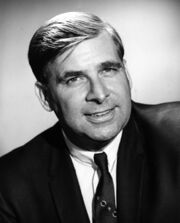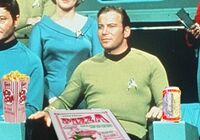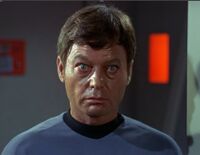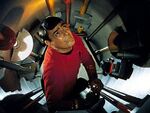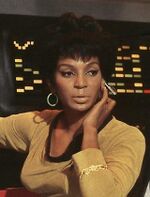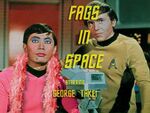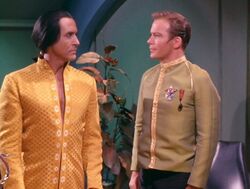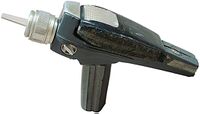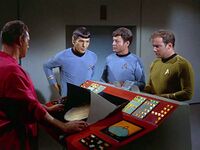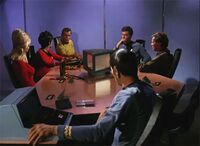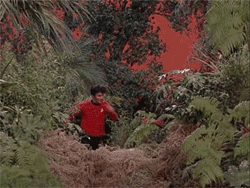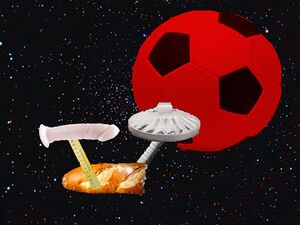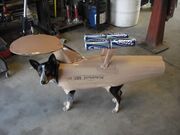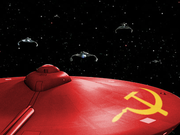Star Trek: The Original Series
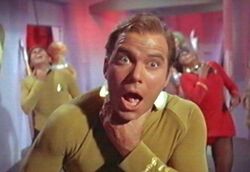
Star Trek: The Original Series (known as just Star Trek at the time) vowed to show humanity just how dehumanizing space exploration can be 300 years from now. What it didn't predict was that Elon Musk and Jeff Bezos wanted conquer the Milky Way for private business.
Pitching Star Trek[edit]
Failed Astronaut and middling TV script writer Gene Roddenberry went to TV Executives at Paramount to discuss his ideas by using this music video. "I wanted to name the series after my favourite cat 'Star Trek: The Next Generation' but they didn't believe this to be a snappy enough title. They compromised with 'Star Trek' and to be fair, the cat would still answer to that name as long as he knew there was a bit of food in it for him."
On the strength of the pitch, a pilot entitled "La Cage" was commissioned. A misunderstanding with the Paramount wardrobe department who thought the title was short for La Cage aux Folles, the original cast were presented with costumes designed for a gay French musical. The original star of the show Jeffrey Hunter walked out after filming two scenes with a woman covered in metallic paint and a wrestling contest with a bald man in a g-string. A union dispute over a cookie allocation caused a strike at Paramount and so filming was cancelled in favour of shouting. A year later (the time it takes the Earth to orbit the Sun) Roddenberry pitched another story and "Where No Man Has Gone Before" (about a woman - a species no Star Trek fan has yet discovered) was produced. A dispute over an on-set alleged masturbation by an alien extra brought the second strike, and Roddenberry was forced to start again, eventually making "The Man Trap" (sponsored by Morton Salt), which wasn't very good but had a reasonable gay following.
TV Executive Marcus Howdawg decided to support the show despite low pilot ratings, as he found the show to be a great escape from the demands of his feminist girlfriend - who had only the week before asked him to have a 'conversation'.
Regular characters[edit]
James The Kirk[edit]
To get the nucleus of the character of Kirk, you have to look at his slight paunch. Roddenbury was insistent that the Captain of the Enterprise should be a man who the audience could engage with and as such he insisted Shatner looked like the kind of guy who is a sexy beast, the kind of guy who could sleep with more women per year than every other man in the history of the world has only thought about having sex per year (and this counts just thinking about the possibility of having sex).
However, in an attempt to humanize the image of the actor (William Shakespeare) they subsequently had Kirk sleep with only some women on the show so all other men on the planet can not be threathened by his supreme awesomness.
Spock[edit]
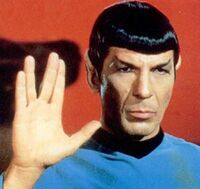
Often referred to as Kirk's "shipboard wife", the character of Spock was, in fact, based on the little known, and exotic (to most Star Trek fans) gender, "women". The writers were strongly influenced by their disinterested and disdainful wives who would regard their husbands every action as, "Illogical!", "Watching grown men chase a ball around a field!", they would protest.
Plans to have an alien race in the series called "Women" was overruled by the only member of the production staff not under the influence of some particularly potent Skunk. This overruling was never challenged, because most Nerds seldom encounter "Women", so are not fully aware of their existence. Instead they settled upon the compromise of having a race in which both genders would act in a similarly, irritatingly logical manner.
Being a Vulcan, Spock apparently experiences a state known as the Pon Farr, but for reasons of some possible hormonal abnormality, seems to be trapped in it permanently. Though, he won’t talk about it... to anyone... at all. “Leave me alone! We do not discuss it with off-worlders.” Instead, he is obliged to sneak around demonstrating it, at every available opportunity, to almost any female who manages to avoid Captain Kirk. When not emerging from these well timed, romantic, musical interludes (generally, following a commercial) he spends much of his time: weeping, moping, throwing objects in rage, incensed with indignation, exploding in bouts of hysteria, sulking, laughing, crying, smirking, or smashing things in anger, when not murderously attempting to asphyxiate a close friend. Aside from this, he appears to have an amazing degree of control over his emotions.
Doctor McCoy[edit]
Known as 'Bones' because of the fused and individual bones supported and supplemented by ligaments, tendons, muscles and cartilage that go into making up his skeleton, Bones has no medical knowledge whatsoever due to technological advances making such skills redundant. He simply follows instructions given to him by moving triangles on the wall of his sick-bay. His pronouncements of "He's dead Jim" given during away missions, are the guess of an amateur or prompted by some special hand held device. His primary duties are to loiter on the bridge, to lean on the railings, and to be an annoyance and impairment to command procedures. He is the only drug dealer allowed on the Enterprise.
Welshy[edit]
Convicted murderer James Doohan played the role of Montgomery Scott, the ship's chief engineer. Doohan was considered too dangerous to interact with the other actors and thus all his scenes were filmed in his cell in the West LA Correctional Facilty, decorated to look like the engine room. The set eventually had to be digitally added, because Doohan kept killing his guards with the styrofoam walls in his eager bids at freedom. He eventually escaped and went on a murder spree in which the only connection between the victims was that they were wearing red shirts.
Foreigners[edit]
Renowned racist Roddenberry insisted on having ethnic minorities in the Star Trek crew so as to give them nothing of any use to do, thus reinforcing the stereotype of lazy foreigners. So underused were the characters of Sulu and Chekov, they were both replaced by mannequins in the third-series. The only line they would ever utter in this final year was the pre-recorded 'Aye Aye Captain'.
Nichelle Nichols broke ground by being the first actress to appear in a sci-fi series with a 'disconnected ear'. Nichelle's right ear was chopped off in a bread-slicing accident weeks before filming commenced; this forced her to play the part of Uhura whilst continuously holding her ear in position allowing her to hear her colleague's lines. Unfortunately, this meant she was recast from her intended role of futuristic African sex slave to that of Telephone Operator.
Red Jumper Row[edit]
Reece Binspoon of Utah, convicted of the old first-degree, was the first man in the USA to be executed for real on a prime-time television drama. An initiative of Roddenberry and the American Government, men from death-row would be executed whilst playing minor characters on away-missions. Such executions were not compulsory; Death Row inmates had to volunteer to have their death recorded as part of a Star Trek episode. "Nobody can forgive these people for the crimes they have committed," Roddenberry said at the time, " but in having their life taken for the entertainment of an American audience, at least they are giving their victims families some comfort."
Amnesty International refused to campaign against this practice stating, "Whilst we understand why some consider this barbaric, the first consideration is how the execution serves the narrative of an episode."
Guest stars[edit]
A variety of guest stars appeared to make the series seem more realistic. Most were former sex partners of Gene Roddenberry and his horses. For many, it became the line on their resume they usually highlighted and put three exclamation points after.
Ricardo Montalban used it to break out of his Latin-lover stereotype and progress to roles as Sikh-lovers. Michael Dunn's growth as a thespian was stunted because his toga was needed for alien women's clothing. Diana Muldaur spring-boarded her career by guesting twice on Star Trek. This led to many roles on NBC Mystery Movies and, to the chagrin of Trekkie redheads, the sexy second-season doctor on ST:TNG, Dr. Pulaski. Maria, her child fathered by Roddenberry, sang Midnight at the Oasis but nothing else worth mentioning. Roger C. Carmel was hired thrice to characterize Harcourt Fenton Mudd, including his more lifelike portrayal on ST:The Animated Series. Julie Newmar's stunning performance in Friday's Child led most people to believe she was even weirder than her Catwoman character made her look. John Drew Barrymore's failure to show when contracted to play Lazarus broke his family's heart and led to his subsequent years as a pious monk. As Elaan of Troyius, France Nuyen confirmed rumors that Vietnamese men had a chance with French women.
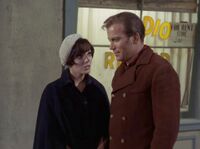
A pre-Dynasty Joan Collins turned up in one episode playing a 20th century charity worker whose influence changed world history. She had stopped the USA from participating in World War Two and had been an American Firster. Joan had a bob haircut and was distinctly unsexy in the episode. She barely had a smooch with Captain Kirk before being runover by a delivery van.
Quite a few has-been actors were lucky enough to be cast on the sequel shows. John Colicos reprised his role as Kor, a war-mongering Klingon-Canadian. Mark Lenard came back as Sarek although he'll always be most famous as Aaron Stempel on Here Come the Brides. Michael J. Pollard, however, was unwilling to play a child on ST:Voyager. Ron Howard's goofy-looking brother Clint portrayed a goofy-looking American on ST:DS9. Majel Barrett Roddenberry's voice, of course, was used as the voice of each of Stephen Hawking's wives. Her Lwaxana Troi character on ST:TNG won a Saturn Award in the category for Best Captain-Tease.
Weapons[edit]
Phasers[edit]
Phasers are common energy-plasma weapons used on Star Trek. The word "phaser" is an acronym of "Photon Amplification by the Stimulated Emission of Radish-gas". The weapon emits a beam of a type of subatomic particles known in 23rd-century scientific terminology as "rapid nerdons". Upon being fired at a sentient being aboard a spaceship, space station or outside the atmosphere of a planet, these particles cause the pores in the skin of the buttocks to form a suction, usually resulting in the victim's underpants, if worn, to suddenly cling to the buttocks. This is known in Starfleet Academy parlance as a "space wedgie".
Phasers come in several different sizes, from small hand-held models to big ol' whoopass ship-mounted cannons. Hand-phasers can be small enough to be concealed in the user's palm, while still usable for administering the near-lethal "wedgie". The smallest model used in The Original Series could be snapped onto the back of the somewhat larger pistol-handled model for additional range, to the shock of distant bystanders who would have no idea of the space wedgie's origin.
Upon depletion of energy, a portable nerdon energy packet could be connected to the weapon for recharging. When this ran out, rubberbands were wrapped around the top of the weapon from front to back, which could be flicked off with the thumb, causing the band to fly forward and slap into the targeted person's face. Thus Kirk could have shot one at Charlie X and said, "That'll teach you to sit in my chair, you scene-stealing, up-staging little punk!" (Though since he had none, he had to settle for picking him up by the rear elastic of his underpants and giving him a brownie).
Klingons have been known to get angry and belligerent after having rubberbands shot at their faces. Vulcans, while usually maintaining a calm composure afterwards, have described it as "highly annoying", and it has sometimes been known to trigger a premature Pon Farr, much to the surprise of the shooter.
Huge whoopass rubberbands can also be connected to the external ship's phasers and shot down at the surface of a planet, if the ship is in orbit. When the Enterprise encountered Apollo in "Who Mourns for Adonis" holding his hand over the saucer section of the Enterprise and warning them, "You will obey me... lest I close my hand", Kirk ordered a huge-ass rubberband shot down at his face. "Ow!" Apollo shrieked, looking up at the sky. "Where'd that come from?"
Later when Kirk became aware that Apollo had the intention of impregnating one of the female crew members, he ordered Sulu to shoot another one, this time aiming a little lower. When it smacked into Apollo's crotch, he raised one knee exclaiming, "Dang, that smarts!"
However, due to his being within the atmosphere of a planet, as well as his composition consisting of energy, when a phaser was fired at him, instead of creating a suction in the pores of his buttocks, it merely caused the abdominal gases present in the colon to begin increasing rapidly. "Dang, that gave me the farts!" he exclaimed.
When the landing party beamed down, they were all seen holding their noses, exclaiming "P-U!" though the 1960s TV censors required the sound to be turned off for that part.
Special Effects[edit]
Without the complex jiggery-pokery of Computer Graphics Innit (CGI), producing a fictional action series set in space was always an expensive and troublesome operation. It meant such programs had to be filmed in space itself. Though a full mock-up of The Enterprise was built, it did not have its own engines and thus had to be pulled around by ropes attached to a Jupiter space rocket.
Many papier-mache boulders were depicted on the surfaces of the planets visited. Due to the limited budget, these were simulated by the use of real boulders painted to look like papier-mache. This, however, caused a large number of fatal accidents: thus the tradition of Red Shirt fatalities, and Dr. McCoy's catch phrase began. Director: "Gene! Some dummy just banged his head on a boulder again!" Gene: "So?!... Just put a red shirt on 'em, and have DeForest say, 'He's dead, Jim.' "
Gene Roddenberry gave away a few tricks of the trade in an interview with Walter Cronkite - though due to the zero-gravity environment in which the interview took place, all of the letter u's floated away: "Obviosly, in the corse of the series, The Enterprise visits a nmber of alien worlds. With the limited range of the Jpiter rocket, we cold only really get to the moon, and though we toyed with the idea of the Enterprise continally discovering the Moon every episode, we finally conceded this would be fcking appalling. Ths we jst painted the moon different colors to represent different planets visited. Granted the moon is only a third of the size of Earth, bt painting it did take a considerable amont of time and indeed paint, especially in near weightless conditions".
By the third season of Star Trek, Lenard Nimoy's insistence that his prosthetic ears be made entirely out of gold meant that budget cuts had to be found elsewhere. This forced the production team to abandon out in space filming and use models. "It wasn't ideal", William Shatner commented from his own mouth by the dexterity of his tongue, "but we just had to work around it and only use half of it. It's sad in a way - but so was the death of Princess Diana and the end of the movie E.T"
Language[edit]
The first series was performed entirely in the original Klingon with no subtitles, in an attempt to appeal to the fictional alien species. The experiment proved unsuccessful, and later series used the language spoken by the Queen of England, though a variety of it spoken by a group of England's colonies that rebelled in 1776.
Narrative Devices to Allow Deep Space Travel[edit]
Gene's first problem was to design and build a ship of the size and technological girth to house, support and maintain almost twelve crew members the forty years it would take for the show to reach cult status. When first planning the opening episodes he went through various issues of ship design and locomotion, eventually settling on attaching the ship to seventeen herds of wild Space-Terriers, which can best be described as massive fast moving asteroids with legs, tail and wet tongues. To the left is a rare photo of the Starship Enterprise under a new idea whereby the motorisation of the space ship was controlled by up to eight beer in industrial sized metallic cans. This design soon became the standard all future Enterprise would be based on.
You have to travel pretty fast to travel around outer-space and Roddenberry knew this. He came up with a measurement called Warp Speed whilst ice skating in Belgium. "I decided to make Warp 1 equal to 100mph." Roddenberry explained, "I know this sounds fast for, what is effectively the Enterprise’s first gear, but I don't think you should misunderestimatistand the size of outer-space. It's many times larger than earth. It’s bigger than America for god’s sake!"
Warp 2 became 200mph and then up in 100 mph chunks with warp 9 being 900mph. "Warp 10 was 2000mph instead of 1000mph because I felt that it should be an out-there kind of figure." Roddenberry continued, "Twice the speed of Concorde - in effect - the Enterprise travelling at full-whack could get you from London to Sydney in just two hours!!"
Star Trek’s Politics[edit]
Continuous drunken accusations that Star Trek has connections to communism have dogged the show rather like a dog would. Money abolished - in Star Trek's universe absolutely. And if that wasn't enough it is argued, the left of left helter-skelter ran to treating women and blacks with respect. Of course religion is no match for technology in this red spockosphere. Gregorian calendar? Not a chance - we're working with Tsar-dates here. If a five year mission sounds like a long time, a five year plan most certainly does not.
On-set relationships[edit]
Much has been written about the frosty atmosphere present on set between Shatner and his co-stars. ”Personally I’ve never had a problem with the fat prick, dammit”, DeForest Kelly said in an interview published in the July 1991 edition of Efficient Baking , “ But it did grow slightly tiring when Bill would constantly insist on improvising rather than following the script. His off the cuff remark that he had to go call his wife totally ruined the tension of my removal of Spock’s brain. Kirk didn’t even have a wife dammit.”
”I said at the time and I’ll say it again” Kirk has since responded, ”This is sci-fi man, it’s out of space…you guys ever heard of time-travel?’
No More Old Trekkers[edit]
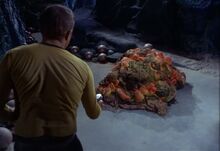
After the last Star Trek film featuring the original cast came out in 1991, expectations that Bill and the Boys (and one girl) were going to get another adventure diminished quickly. Old resentment on billing and who was more important for show held up any chance of a new film. By the turn of the 2000s some had already passed on the great Bridge in the Sky, others were loopy lou. In 2009, Paramount finally decided to soft-reboot the series as a J.J. Abrams film franchise. This new series was set in a divergent timeline from the Original Series, featuring a young cast playing characters like Kirk and Spock, and also cameos from old cast members; however, only Leonard Nimoy appeared as the Ghost of Star Trek Past, as Shatner had missed his flight. The first film, Star Trek '09, received generally positive reviews from fans and critics, who thought it was a decent parody of the original Star Trek, but the next two films, Into Darkness and Beyond, faced diminishing returns.
